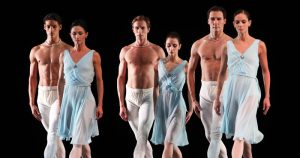Dutch National Ballet: Van Dantzig, van Manen, van Schayk / Mixed Bill - Vancouver Ballet Society
- Home
- Reviews 2014 - 2019
- Dutch National Ballet: Van Dantzig, van Manen, van Schayk / Mixed Bill

by Judith Delmé
When someone mentions “Dutch Masters,” the golden age of Dutch painting with 17th-century artists like Rembrandt, Vermeer and Frans Hals springs to mind. Less well-known, but retaining a unique position in the history of dance, are a trio who epitomize the “Holland School” of the 1970s to 1980s. Known affectionately as “the three Vans,” Rudi van Dantzig, Hans van Manen and Toer van Schayk are the Dutch masters to whom the Dutch National Ballet paid tribute this September.
Although it was the company’s founder, the redoubtable Sonia Gaskell (with whom these men took their first dance lessons), who first paved the way for serious ballet in Holland, it was the three Vans’ unique approach to dance that attracted worldwide interest, drawing stars like Rudolf Nureyev to their door. Classical ballet was their preferred language, but it was their usage of a crossover culture, a combination of modern and classical dance, which first put each of them on the map.
This is not to say that the three Vans followed the same creative path; on the contrary, the subtle geometry of van Manen differed widely from van Schayk’s plasticity and from van Dantzig’s sombre emotional offerings. The four works that made up the program (two from van Schayk, who turned 80 this month) were typical examples of each choreographer’s oeuvre; they slotted together well to give a picture of the emergence of European neoclassical dance.
Toer van Schayk has been called a Renaissance man, a man of many talents: choreographer, costume designer, painter, sculptor, musician, lighting designer. His premiere, Episodes of Fragments, set to music by 19th-century Belgian violinist Eugène-Auguste Ysaÿe, opened the program. It was an 11-minute piece for two couples — two dancers (Qian Liu and Young Gyu Choi, dressed in pink and grey) and a violinist and pianist, all invisibly bound by the music. Van Schayk is known to choreograph by first sketching in detail each step, notating movement from pose to pose; his musical sense and sculptor’s eye transformed these static drawings into flowing dance. The dancers’ arms traced huge arcs away and around the body and an arabesque stretched to form a continuous line with a deep lunge.
If Episodes was a distillation of the music, the program’s finale, Requiem (1990), set to Mozart’s sublime death mass, was a monumental cry from the heart. Van Schayk painted his ballet in broad, vivid strokes. The décor was a giant black grid onto which were projected videos, fragments portraying the horrors of war, devastation of the planet and destruction of animal life. The focus of the choreography was not merely on steps, but rather on the manner in which the 40-odd dancers (dressed in sombre grey leotards) were manipulated in swathes in and out of complex formations: women lifted in positions of crucifixion; men’s aggressive behaviour; the solitude of individuals; and the suffering of the chained. It was confrontational and totally unforgettable.
The exquisite centrepiece of the evening was Hans van Manen’s 1970s’ masterpiece Adagio Hammerklavier. To fully illustrate the beauty of adagio movement, he chose a version by pianist Christoph Eschenbach, played four minutes slower than is customary. The abstract theme marked the ebb and flow of a single relationship, with van Manen’s hand very evident in the minimal, pared-down style.
Lights went up on a static group (three women in light blue dresses, three bare-torsoed men in white tights) backed by a wind-blown curtain. They separated into pairs — there was an uneasy tension to the first duet (Anna Ol and Artur Shesterikov) and movement was grounded: even when Ol repeated her high leg extension, she released each time into a deep backbend, supported by her partner.
In the second duet (Anna Tsygankova and Daniel Camargo), the emphasis was on high lifts and big free lines, allowing emotions free rein. Harmony returned in the third (Igone de Jongh and Jozef Varga) and there was a glorious moment when all three women were lifted, knees bent, feet angled before they slowly bent back and extended their legs into arabesque en l’air.
Although Rudi van Dantzig’s Four Last Songs, which followed Episodes, is considered a seminal work, it came over the least well. Set to the eponymous score by Richard Strauss and based on texts by German poets, the cycle describes death as natural and unavoidable.
Four duets, eight couples — one pair setting the mood for each section (Spring, Autumn, Dusk and Evening), while a soloist linked all together. The Angel of Death (tall Vito Mazzeo) at times separated, at times bound the couples and finally accompanied them as if to their final rest. Mazzeo’s feline jumps, long line and sinuous quality were outstanding, but the rest of the choreography was unremarkable and overshadowed by the haunting music. Although the ballet was groundbreaking in the 1970s, today it was distinguished mainly by that fact and by the heartfelt portrayal from the fine Dutch dancers.
DI WINTER 2016

